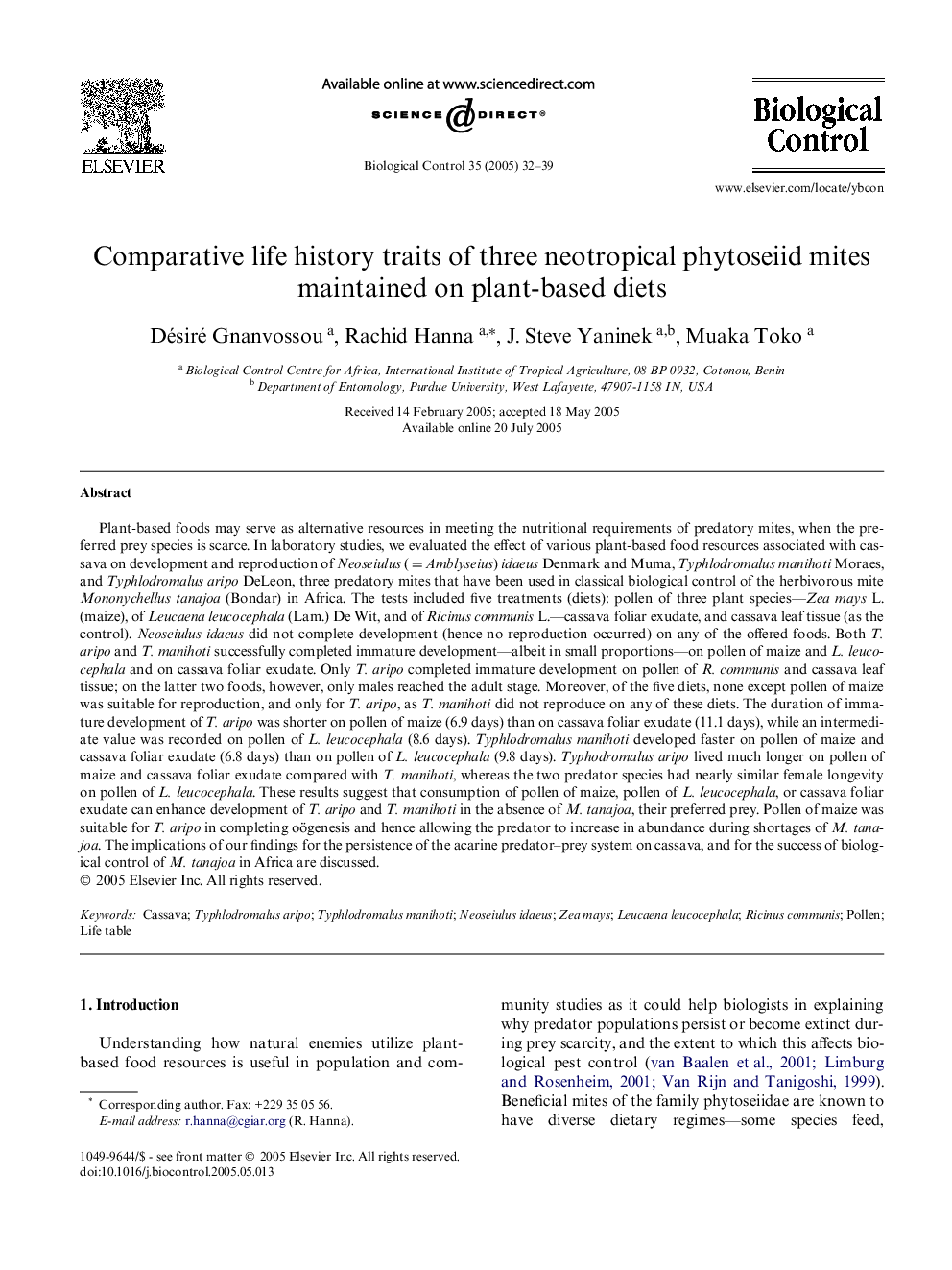| کد مقاله | کد نشریه | سال انتشار | مقاله انگلیسی | نسخه تمام متن |
|---|---|---|---|---|
| 9471914 | 1321145 | 2005 | 8 صفحه PDF | دانلود رایگان |
عنوان انگلیسی مقاله ISI
Comparative life history traits of three neotropical phytoseiid mites maintained on plant-based diets
دانلود مقاله + سفارش ترجمه
دانلود مقاله ISI انگلیسی
رایگان برای ایرانیان
کلمات کلیدی
موضوعات مرتبط
علوم زیستی و بیوفناوری
علوم کشاورزی و بیولوژیک
علوم زراعت و اصلاح نباتات
پیش نمایش صفحه اول مقاله

چکیده انگلیسی
Plant-based foods may serve as alternative resources in meeting the nutritional requirements of predatory mites, when the preferred prey species is scarce. In laboratory studies, we evaluated the effect of various plant-based food resources associated with cassava on development and reproduction of Neoseiulus (=Amblyseius) idaeus Denmark and Muma, Typhlodromalus manihoti Moraes, and Typhlodromalus aripo DeLeon, three predatory mites that have been used in classical biological control of the herbivorous mite Mononychellus tanajoa (Bondar) in Africa. The tests included five treatments (diets): pollen of three plant species-Zea mays L. (maize), of Leucaena leucocephala (Lam.) De Wit, and of Ricinus communis L.-cassava foliar exudate, and cassava leaf tissue (as the control). Neoseiulus idaeus did not complete development (hence no reproduction occurred) on any of the offered foods. Both T. aripo and T. manihoti successfully completed immature development-albeit in small proportions-on pollen of maize and L. leucocephala and on cassava foliar exudate. Only T. aripo completed immature development on pollen of R. communis and cassava leaf tissue; on the latter two foods, however, only males reached the adult stage. Moreover, of the five diets, none except pollen of maize was suitable for reproduction, and only for T. aripo, as T. manihoti did not reproduce on any of these diets. The duration of immature development of T. aripo was shorter on pollen of maize (6.9 days) than on cassava foliar exudate (11.1 days), while an intermediate value was recorded on pollen of L. leucocephala (8.6 days). Typhlodromalus manihoti developed faster on pollen of maize and cassava foliar exudate (6.8 days) than on pollen of L. leucocephala (9.8 days). Typhodromalus aripo lived much longer on pollen of maize and cassava foliar exudate compared with T. manihoti, whereas the two predator species had nearly similar female longevity on pollen of L. leucocephala. These results suggest that consumption of pollen of maize, pollen of L. leucocephala, or cassava foliar exudate can enhance development of T. aripo and T. manihoti in the absence of M. tanajoa, their preferred prey. Pollen of maize was suitable for T. aripo in completing oögenesis and hence allowing the predator to increase in abundance during shortages of M. tanajoa. The implications of our findings for the persistence of the acarine predator-prey system on cassava, and for the success of biological control of M. tanajoa in Africa are discussed.
ناشر
Database: Elsevier - ScienceDirect (ساینس دایرکت)
Journal: Biological Control - Volume 35, Issue 1, October 2005, Pages 32-39
Journal: Biological Control - Volume 35, Issue 1, October 2005, Pages 32-39
نویسندگان
Désiré Gnanvossou, Rachid Hanna, J. Steve Yaninek, Muaka Toko,